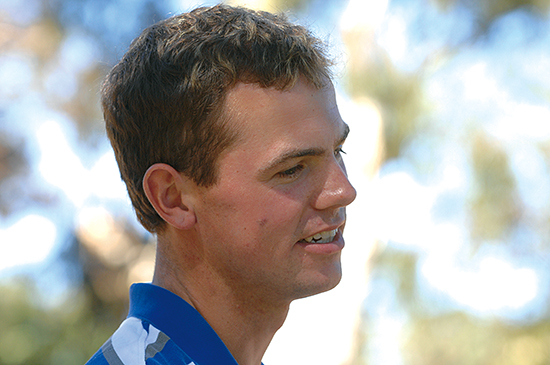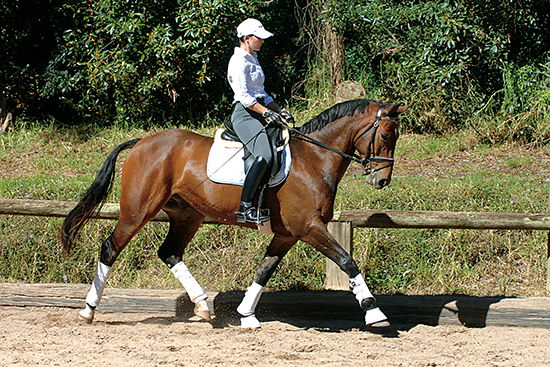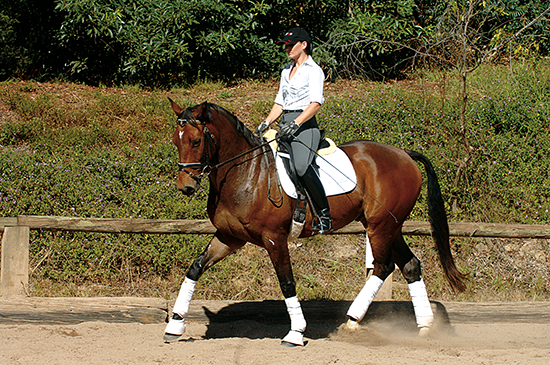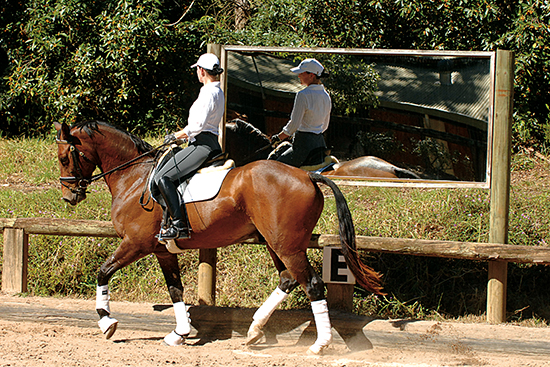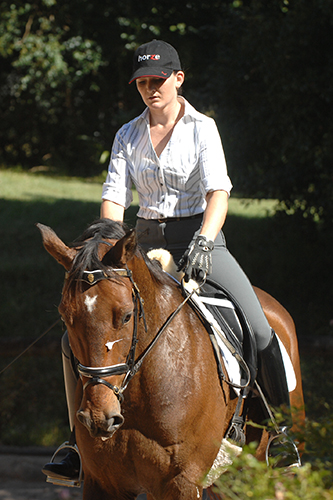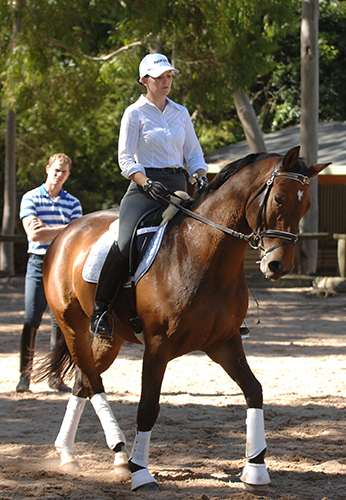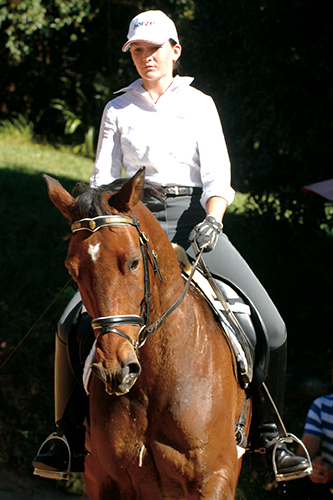 Story by Chris Hector & Photos by Roz Neave
Story by Chris Hector & Photos by Roz Neave
Our latest series with the German dressage trainer, Stefan Wolff started with a Grand Prix horse, then a Prix St Georges horse, and now we finish our working session with a Medium level horse, Tanase Peckham’s five-year-old Winterstern.
Tanase has had him all the way through: “I’ve had him since he was broken in. He is by Fourwinds Wilderness out of a Salute mare, actually a Salute / Connemara mare – there’s not much Connemara in there, but that’s why I think he’s so level headed. He’s got a few brothers at home, so they’ll be interesting coming up. Personality wise, he’s very very opinionated as you could probably tell in the lesson. We’d travelled two hours to get here, and I could feel him saying, ‘come on, what is happening…’”
Tanase is establishing an equestrian centre in the Hunter Valley: “Half an hour past Newcastle. I’m trying to work full-time with the horses. I’m also working in a restaurant at the moment until we can get our business going. We’ve got 160 acres and we are trying to get that set up – breeding and training. I’m 24 years old. It’s a good opportunity with Mum and Dad having the property. I’m travelling back overseas later in the year. Previously I was in Europe for eight months with Rick Klaassen, I was with him for four months, he trained with Georg Theodorescu. Then I was at the same barn as Deiter Laugks who was the trainer for Fiona Bigwood at the time. I also trained with Matthais Vatter who trained with Klaus Balkenhol and Marion Wilimzig, who trained with Reiner Klimke. With Rick I managed to travel around to competitions and have a look at how everything worked over there.”
You are ambitious?
“Yes. I’ll get to the Olympics one day, I just need the horse to get on a squad.”
Have you worked with Stefan before?
“I’ve had one clinic with him before. I get a lot out of working with him – it opens your eyes up though! It makes you realise what you are doing wrong and what you need to fix.”
It was the horse’s first visit to the Dierks’ establishment, and Tanase had a little difficulty getting his mind on the job, but once again, the message was the same – it’s all about honest, athletic contact. The visiting German trainer, was in the centre of the arena, helping the rider gymnasticize her horse…
“Bend him into the rein and off the hand. Make it more comfortable and easy but be a little stricter from behind. Make him more obedient to your leg.”
And yes, forward is still the message: “Make him rounder, more through the neck – he needs to be oriented more forward. Round, round, make sure you don’t block. To bring a horse back, you collect the movement, not block the movement.”
And to show Tanase how to work through the problem, Stefan had her riding shoulder-in trot to shoulder-in walk: “He’s pushing himself off the bit, you must get him more thinking forward and to the bit. Don’t put your hand up, the giving is towards the mouth.”
“Make sure you are not hiding problems in training. We want to find problems to work them out. Be more demanding. Insist from behind – low hands, don’t pull at the same time. Make sure when you have more impulsion it doesn’t make him uncomfortable in the mouth. Get him softer in the neck so you are not carrying the balance in your hands. He has to carry the balance himself.”
“Never upwards with the hands, low hands. Every single muscle fibre in the horse’s neck has to be supple. Keep playing, soft, active hands. He’s hanging on your hands, so keep your hands working. Walk, then trot, to work it out. You need to find a way. Don’t be scared that he is a little strong; we will work out a way to keep the expression, but also have him soften. That’s the result we are working for.”
“It’s not enough that the horse is in the right position. The horse shows you the problem. Your hand is just following him, not asking more and getting him more through from behind. You’re not at a show, work through the problem, don’t hide it. You need to have the power to change him – not a stiff neck against the rein. Only bring him back when he softens the neck. Bring him back, then lighten, keep him orientated to the bit. Be playful; be clever with your hands. It’s the next phase in your training.”
“Now do you feel the difference between through the neck and against the rein? Make sure your hand is not too hard, that it is always clever, and the elbow stays on your body…”
Stefan felt that Tanase needed to demand more of her horse…
“I think that’s a nice little horse, and a talented rider with a nice seat. Very good basics. I think she has to make her way now to be a little more demanding. I think her horse offers a lot, it is quite easy for the rider, which is nice. I think they are now at a stage where the rider has to ask more, get more impulsion, and then later on, start with collection.”
It was an interesting exercise you were doing with her: trot shoulder-in, hold the shoulder-in and transition to walk…
“The horse is behind the bit, which is not very obvious. Some horses don’t show that they are behind the bit, but they are, and it is hard to have an honest tendency from impulsion behind, over the back, through the neck to the bit. The horse shows a nice rhythm and seems to be nice, but as soon as you want to do a half halt or transition, it had little interruptions in the flow of the movement. For this problem, trot / walk transitions are an easy and effective way to first of all show the rider the problem, and then also to work that problem out. I think after doing those walk / trot transitions, first on the straight line, later as a more advanced exercise in shoulder in, we see that the horse would more and more, accept the half halt and work more through the body.”
“After we worked him the first day, more from behind, in order to get more impulsion and expression in the movement, it appeared that he got stronger. The problem was that the horse is not properly working through the neck, the problem was always there, but now it shows up. The rider is a very talented rider who can hide things, so it wasn’t so obvious. But it showed up that the horse was not as well through the neck as it seemed to be. I think it was a problem that the rider was not aware of, so I wanted to spend time working on the suppleness of the neck. So that we have the impulsion we wanted, the better rhythm, plus a nice comfortable contact.”
“I used the half pass to show the rider the problem. It is not enough if I know the problem and tell the rider what to do. What is important is that the rider understands the problems and we can solve it together, so the rider knows after the clinic what she did, and why she did it. I wanted to show her how the horse was crooked to one side, not in a bad way, but still stronger on one side than on the other, and that in order to straighten the horse, that she should not use the stronger rein, the rein on the stronger side of the horse only, but also to keep the horse stable on his hollow side. When it is stable, the hand of the strong side has the possibility to work through.”
Tanase was thinking hard after her training session on keeping the forwardness…
“Yes, he has a tendency to question – I think that’s the best word – everything I do. Every time we come back in transitions he has a tendency to suck back and try not to use himself properly, so that’s what we were trying to do, get him through, and not to question so much, just to do it nice and soft and calmly. That’s what Stefan keeps saying, the horse has to be using himself properly before you can start work, but it makes sense, a runner can’t run properly if he is not using his muscles properly. Training at home on my own for a while, then coming here, it does really open your eyes.”
What level is your horse competing at?
“He’s having his first start at Medium, he’s only five.”
Who are you going over to work with this time when you go overseas?
“Coby van Baalen, that should be good. I’m aiming to go for three months, I’ve got so many horses at home that I can’t leave them for too long. I’m trying to plan to go back every year, three months every year will keep me going.”
“Eight months last time was great. I considered staying there longer but finding somewhere to move on to was a bit of a problem. So I came back and got stuck into the babies. That’s the worst part, you go for too long and you come back and there are so many babies that need work!”
And Tanase is not the only one on the move, Stefan has recently moved to America… different?
“Yep. Of course it is very different from Germany – there are not many places on earth where density of the whole sport of riding is as dense as it is in Germany. When you start somewhere new, you start at the very bottom, you have new clients, new horses, it takes a little time.”
We in Australia don’t have that same attitude of discipline in our riding and training that you find in Germany – is it like that in America?
“I have found both. I haven’t been there so long but I have very very focussed riders there, but maybe the mentality in Germany is more serious than most of the other countries.”
Are you finding nice horses to work with in America?
“I have nice horses, very nice horses. They are all imported, but I know that breeding in America is also developing and going pretty well. They have a lot of good breeding programs, and I think in a couple of years, it will also be interesting for the Americans to buy in their own country.”
The standard of the competition?
“I am in southern California and we are pretty lucky. We have a lot of shows up to Grand Prix in Burbank, Del Mar – and there are more shows in northern California. Of course unless it is a CDI, the number of starters, is a lot smaller than Germany.”
Are you enjoying it?
“We are, it’s a great experience to live in another country and just get a wider horizon – of course you make contacts too. So far we are just having a lot of fun and enjoying it.”




